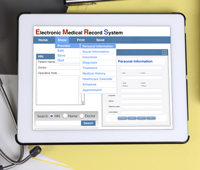By David Thill
Med students at the Indiana University School of Medicine learn the benefits, and potential for improvement, of electronic medical records
Editor’s note: Sensing a gap between how physicians are educated and the future needs of the U.S. healthcare system, the American Medical Association in 2013 launched its “Accelerating Change in Medical Education” initiative. The association awarded grants to 11 medical schools to fund selected innovations in medical education, and then expanded the program in 2015 to an additional 20 schools. Here’s a look at one program shaping tomorrow’s physicians – and Repertoire readers’ customers of tomorrow.
 It’s a safe bet that the physicians you call on in the future will be proficient in using electronic medical records, not only to manage their own patients, but to better understand broader “population health” trends.
It’s a safe bet that the physicians you call on in the future will be proficient in using electronic medical records, not only to manage their own patients, but to better understand broader “population health” trends.
The Indiana University School of Medicine is making sure its graduates are prepared for that future.
Over the course of about 40 years, the Regenstrief Institute, a research support organization of the Indiana University School of Medicine, has developed its Regenstrief Medical Record System, one of the nation’s first electronic medical record (EMR) systems. It captures data for over 10 million patients from Eskenazi Health, in Indianapolis, and its affiliated clinics.
Parallel EMR
This past August, the IU School of Medicine implemented what it is calling the teaching electronic medical record (tEMR). It did so in partnership with the Regenstrief Institute, with a grant from the American Medical Association’s “Accelerating Change in Medical Education” initiative. The objective is to use the EMR as the basis for an educational tool for medical students.
Project organizers wanted to “find a way to create a parallel electronic medical record system that would allow teaching opportunities to be developed” with the EMR, says Bradley L. Allen, M.D., Ph.D., senior associate dean for medical student education in the School of Medicine.
Using the AMA grant, the School of Medicine has worked with representatives from the Regenstrief Institute to “de-identify” the patient data in the EMR. They have substituted actual patients’ names with fictitious ones, so that students can track patients through the medical system.
By the end of the process, 10,000 patients will have been de-identified to form the tEMR, so that groups and demographics can be distinguished within the patient base. This way, the tool can be used to study population health topics, Allen says.
By interacting with the tEMR, students should be prepared to navigate these types of electronic database systems more effectively when they begin practicing professionally, says Allen. What’s more, they will be prepared to actually improve EMR systems in the future. “They will see various EMR concepts in action once they start their clinical rotations and oftentimes may have opportunities to become involved in quality improvement and patient safety efforts as students and residents.”
By training students in modern concepts such as the EMR, says Allen, “I think we will be creating a future cadre of physicians that will be more accepting of these principles.” Given that experience, “they can take on leadership roles within their workplace to develop and refine aspects of EMR systems or utilization to improve patient care.”
David Thill is a contributing editor for Repertoire.